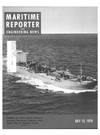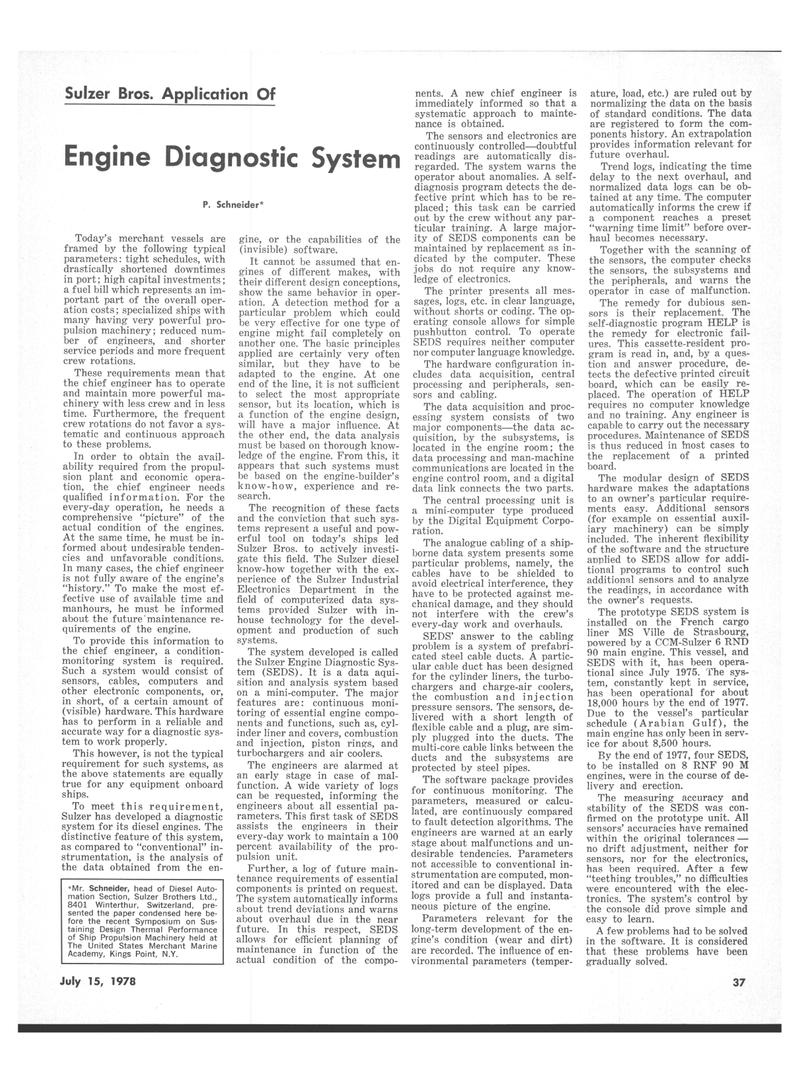
Page 35: of Maritime Reporter Magazine (July 15, 1978)
Read this page in Pdf, Flash or Html5 edition of July 15, 1978 Maritime Reporter Magazine
Sulzer Bros. Applicotion Of
Engine Diagnostic System
P. Schneider*
Today's merchant vessels are framed by the following typical parameters: tight schedules, with drastically shortened downtimes in port; high capital investments; a fuel bill which represents an im- portant part of the overall oper- ation costs; specialized ships with many having very powerful pro- pulsion machinery; reduced num- ber of engineers, and shorter service periods and more frequent crew rotations.
These requirements mean that the chief engineer has to operate and maintain more powerful ma- chinery with less crew and in less time. Furthermore, the frequent crew rotations do not favor a sys- tematic and continuous approach to these problems.
In order to obtain the avail- ability required from the propul- sion plant and economic opera- tion, the chief engineer needs qualified information. For the every-day operation, he needs a comprehensive "picture" of the actual condition of the engines.
At the same time, he must be in- formed about undesirable tenden- cies and unfavorable conditions.
In many cases, the chief engineer is not fully aware of the engine's "history." To make the most ef- fective use of available time and manhours, he must be informed about the future'maintenance re- quirements of the engine.
To provide this information to the chief engineer, a condition- monitoring system is required.
Such a system would consist of sensors, cables, computers and other electronic components, or, in short, of a certain amount of (visible) hardware. This hardware has to perform in a reliable and accurate way for a diagnostic sys- tem to work properly.
This however, is not the typical requirement for such systems, as the above statements are equally true for any equipment onboard ships.
To meet this requirement,
Sulzer has developed a diagnostic system for its diesel engines. The distinctive feature of this system, as compared to "conventional" in- strumentation, is the analysis of the data obtained from the en- gine, or the capabilities of the (invisible) software.
It cannot be assumed that en- gines of different makes, with their different design conceptions, show the same behavior in oper- ation. A detection method for a particular problem which could be very effective for one type of engine might fail completely on another one. The basic principles applied are certainly very often similar, but they have to be adapted to the engine. At one end of the line, it is not sufficient to select the most appropriate sensor, but its location, which is a function of the engine design, will have a major influence. At the other end, the data analysis must be based on thorough know- ledge of the engine. From this, it appears that such systems must be based on the engine-builder's know-how, experience and re- search.
The recognition of these facts and the conviction that such sys- tems represent a useful and pow- erful tool on today's ships led
Sulzer Bros, to actively investi- gate this field. The Sulzer diesel know-how together with the ex- perience of the Sulzer Industrial
Electronics Department in the field of computerized data sys- tems provided Sulzer with in- house technology for the devel- opment and production of such systems.
The system developed is called the Sulzer Engine Diagnostic Sys- tem (SEDS). It is a data aqui- sition and analysis system based on a mini-computer. The major features are: continuous moni- toring of essential engine compo- nents and functions, such as, cyl- inder liner and covers, combustion and injection, piston rings, and turbochargers and air coolers.
The engineers are alarmed at an early stage in case of mal- function. A wide variety of logs can be requested, informing the engineers about all essential pa- rameters. This first task of SEDS assists the engineers in their every-day work to maintain a 100 percent availability of the pro- pulsion unit.
Further, a log of future main- tenance requirements of essential components is printed on request.
The system automatically informs about trend deviations and warns about overhaul due in the near future. In this respect, SEDS allows for efficient planning of maintenance in function of the actual condition of the compo- nents. A new chief engineer is immediately informed so that a systematic approach to mainte- nance is obtained.
The sensors and electronics are continuously controlled—doubtful readings are automatically dis- regarded. The system warns the operator about anomalies. A self- diagnosis program detects the de- fective print which has to be re- placed; this task can be carried out by the crew without any par- ticular training. A large major- ity of SEDS components can be maintained by replacement as in- dicated by the computer. These jobs do not require any know- ledge of electronics.
The printer presents all mes- sages, logs, etc. in clear language, without shorts or coding. The op- erating console allows for simple pushbutton control. To operate
SEDS requires neither computer nor computer language knowledge.
The hardware configuration in- cludes data acquisition, central processing and peripherals, sen- sors and cabling.
The data acquisition and proc- essing system consists of two major components—the data ac- quisition, by the subsystems, is located in the engine room; the data processing and man-machine communications are located in the engine control room, and a digital data link connects the two parts.
The central processing unit is a mini-computer type produced by the Digital Equipment Corpo- ration.
The analogue cabling of a ship- borne data system presents some particular problems, namely, the cables have to be shielded to avoid electrical interference, they have to be protected against me- chanical damage, and they should not interfere with the crew's every-day work and overhauls.
SEDS' answer to the cabling problem is a system of prefabri- cated steel cable ducts. A partic- ular cable duct has been designed for the cylinder liners, the turbo- chargers and charge-air coolers, the combustion and injection pressure sensors. The sensors, de- livered with a short length of flexible cable and a plug, are sim- ply plugged into tbe ducts. The multi-core cable links between the ducts and the subsystems are protected by steel pipes.
The software package provides for continuous monitoring. The parameters, measured or calcu- lated, are continuously compared to fault detection algorithms. The engineers are warned at an early stage about malfunctions and un- desirable tendencies. Parameters not accessible to conventional in- strumentation are computed, mon- itored and can be displayed. Data logs provide a full and instanta- neous picture of the engine.
Parameters relevant for the long-term development of the en- gine's condition (wear and dirt) are recorded. The influence of en- vironmental parameters (temper- ature, load, etc.) are ruled out by normalizing the data on the basis of standard conditions. The data are registered to form the com- ponents history. An extrapolation provides information relevant for future overhaul.
Trend logs, indicating the time delay to the next overhaul, and normalized data logs can be ob- tained at any time. The computer automatically informs the crew if a component reaches a preset "warning time limit" before over- haul becomes necessary.
Together with the scanning of the sensors, the computer checks the sensors, the subsystems and the peripherals, and warns the operator in case of malfunction.
The remedy for dubious sen- sors is their replacement. The self-diagnostic program HELP is the remedy for electronic fail- ures. This cassette-resident pro- gram is read in, and, by a ques- tion and answer procedure, de- tects the defective printed circuit board, which can be easily re- placed. The operation of HELP requires no computer knowledge and no training. Any engineer is capable to carry out the necessary procedures. Maintenance of SEDS is thus reduced in fnost cases to the replacement of a printed board.
The modular design of SEDS hardware makes the adaptations to an owner's particular require- ments easy. Additional sensors (for example on essential auxil- iary machinery) can be simply included. The inherent flexibility of the software and the structure aoplied to SEDS allow for addi- tional programs to control such additional sensors and to analyze the readings, in accordance with the owner's requests.
The prototype SEDS system is installed on the French cargo liner MS Ville de Strasbourg, cowered by a CCM-Sulzer 6 RND 90 main engine. This vessel, and
SEDS with it, has been opera- tional since July 1975. The sys- tem, constantly kept in service, has been operational for about 18,000 hours by the end of 1977.
Due to the vessel's particular schedule (Arabian Gulf), the main engine has only been in serv- ice for about 8,500 hours.
By the end of 1977, four SEDS, to be installed on 8 RNF 90 M engines, were in the course of de- livery and erection.
The measuring accuracy and stability of the SEDS was con- firmed on the prototype unit. All sensors' accuracies have remained within the original tolerances — no drift adjustment, neither for sensors, nor for the electronics, has been required. After a few "teething troubles," no difficulties were, encountered with the elec- tronics. The system's control by the console did prove simple and easy to learn.
A few problems had to be solved in the software. It is considered that these problems have been gradually solved. *Mr. Schneider, head of Diesel Auto- mation Section, Sulzer Brothers Ltd., 8401 Winterthur, Switzerland, pre- sented the paper condensed here be- fore the recent Symposium on Sus- taining Design Thermal Performance of Ship Propulsion Machinery held at
The United States Merchant Marine
Academy, Kings Point, N.Y.
July 15, 1978 37

 34
34

 36
36
